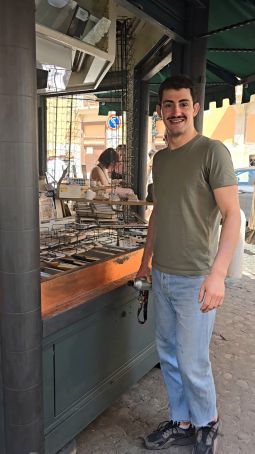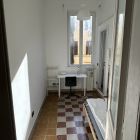It’s 9:42 am, and I am sitting at Caffe Di Rienzo, a caffè latte in hand, with a perfect view of Emanuele’s newsstand, known in Rome as an Edicola.
The surrounding neighborhood buildings cast a shadow over the forest-green walls of the small octagonal structure. The morning is quiet, interrupted only by the low hum of cars and scooters, the whispers of passersby, and the occasional honk of an impatient driver.
As I watch people come and go, I notice Emanuele’s stand being used as a backdrop for photos and temporary shelter from the sun, as if it’s just another prop amidst the cobblestone streets and towering buildings. Have these stands become mere “landmarks” for tourists? Have we forgotten their history, or are we simply culturally unaware?
My thoughts are interrupted as I hear the shutters of the stand roll up, bringing me back to my surroundings. A croissant to-go in hand, I approach Emanuele, who has graciously agreed to meet with me on his day off. He turns, smiling, and says, “Are you the one waiting to meet with me?” I respond, “Yes! And here’s a pastry as a thank you!”

Originally his grandfather’s, the stand used to be in the center of the Pantheon square but was moved in 2008 just west of the landmark on Salita de Cresenzi. The stand had been closed for the past four years, frozen in time with newspapers headlining a possible lockdown dated 2020. After a few touch-ups and inventory changes, the stand officially reopened a month ago.
With the Pantheon still in view,Emanuele reminisces about a time when newspapers were still purchased during his childhood. “I used to live in the square as a kid, and I knew all the bar owners in the area. I knew everyone. Now, especially after COVID and spending time in Taiwan, when I came back to Rome, everything had changed—new businesses and new people. Rome is changing.”
While he must stock newspapers and magazines by law, not many people buy them as the culture has shifted towards digital news. “I sell maybe one a day. This area allows me to play with my inventory because there are many tourists, and I’m still in an area that lets me take it easy. I mostly sell magnets and postcards, but I try to offer different things.”
Most stand owners prioritize foot traffic and the associated revenue, making Emanuele’s location prime real estate for selling tourist knick-knacks. However,Emanuele has a different vision. He can sell the typical “shitty postcards,” but he hopes to make the stand something much more special—a place where local artists and designers can stock his shelves with their creations, offering meaningful gifts instead of miniature Colosseums that will, let’s be honest, end up in garage sales or thrift stores in a few years.
Like any other business owner, he wants to make money and have a profitable venture, but “the law is a bit slower to adapt to times.” So, whileEmanuele continues to stock newspapers as per mandatory regulations, he works towards curating the perfect stand. “It will take more time and effort, but I want to be different from what you see in the city.”
While the stand primarily serves tourists to adapt to the times, we shouldn’t forget its roots in community interaction. Seen as a place to hold conversations, it goes beyond neighborhood gossip. “It’s not only that the community comes to talk to you; it's bigger than that. You are giving the neighborhood something very important—the news. It’s what keeps the community thriving.”
I watched Emanuele assist a few wandering shoppers for a minute, and he looked happy. But nothing beat the smile on his face when a familiar face stopped by the stand. Smiling from ear to ear, Emmanuel lit up with pure joy, engulfed by hugs and excited hellos. At that moment, everything made sense. The world around me paused, and I understood exactly what he had been trying to explain to me for the past half hour. From a distance, the happiness, love, and joy filled the surrounding atmosphere, making me feel right at home.
As a tourist, I wish more newsstands still had the same sense of nostalgia and comfort. Edicolas are not just newsstands. While they may be seen as mini shopping malls for tourists, with Emanuele’s vision, they can become what they used to be. Edicolas can once again keep a neighborhood connected and informed, while also adapting to today’s times by distributing tourist-attracting products in a more elevated way.
At 31 years old, this business venture is not only a way for Emanuele to make the Edicola his own but also a chance to return home. The stand resides in his neighborhood, a special part of his childhood and his family. “Familiar faces, the Italian way, it’s what I missed the most,” he said.
Emanuele, I know you missed your community and the neighborhood, but I think they missed you more.
General Info
View on Map
Rediscovering Rome’s Newsstands Culture
Salita de' Crescenzi, Roma, RM, Italia


















